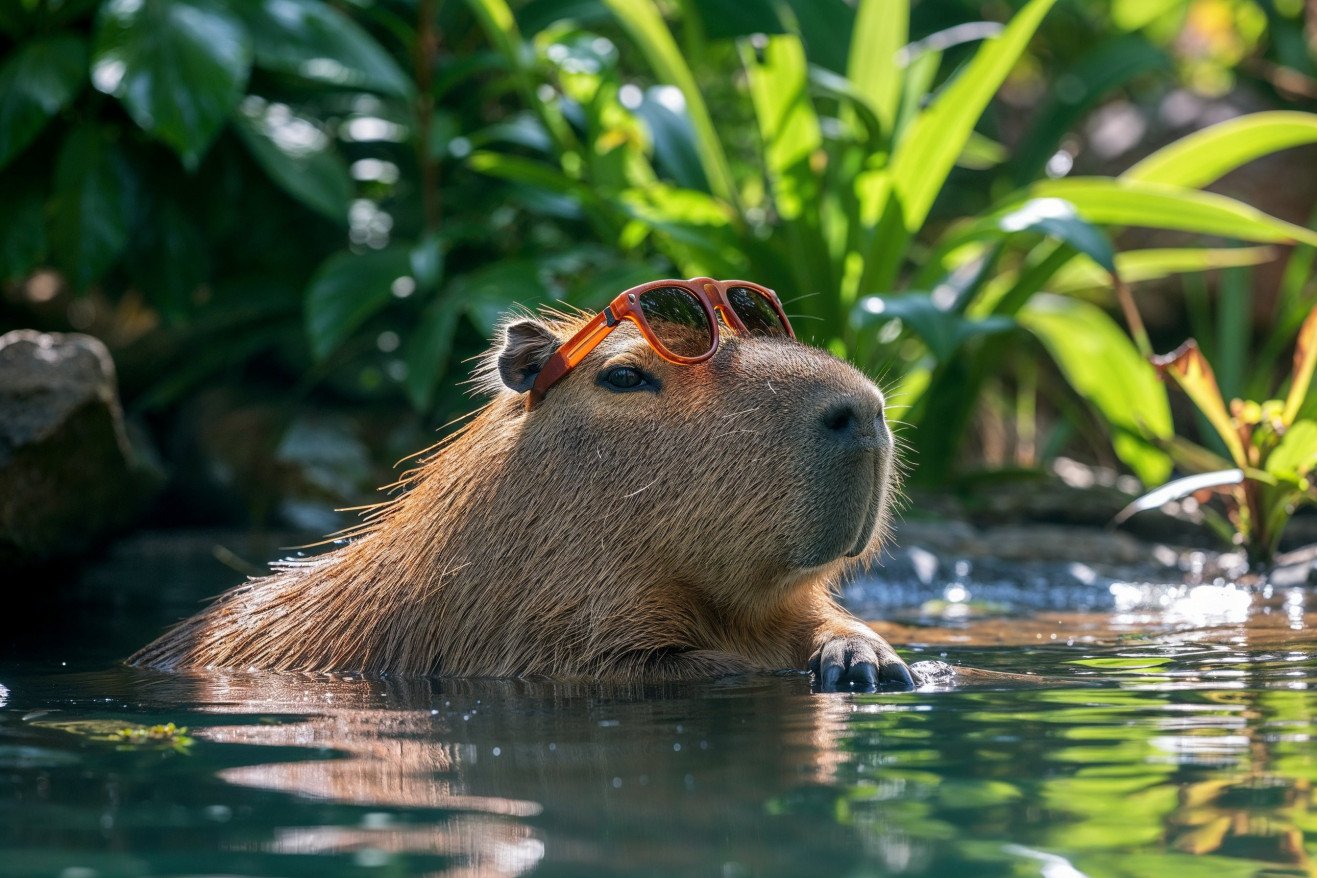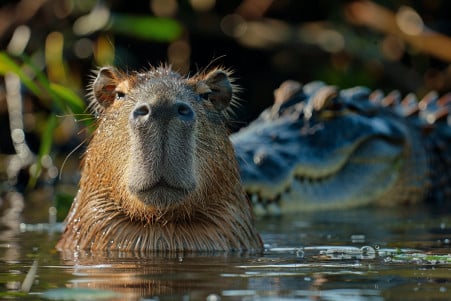Why Are Capybaras So Chill? Uncovering the Secrets of Their Serenity
6 February 2024 • Updated 6 February 2024

Capybaras are known for their chill nature, but what makes these giant rodents so calm? The social structure, herbivorous diet, and lack of natural predators of capybaras all play a role in their calm behavior. Capybaras’ social groups help them stay safe, which reduces their stress, and their semi-aquatic lifestyle makes it easier for them to escape from danger, which also helps them stay calm.
To better understand why capybaras are so chill, this article will review a number of studies from the fields of ethology, ecology, and animal psychology. This will include research on social bonds, stress regulation, and environmental conditions that help make capybaras so relaxed. By integrating these findings, we hope to show how a mix of biological and social factors come together to influence the capybara’s personality, helping you learn more about these friendly animals.
Why are capybaras so chill?
The Social Structure of Capybaras: Strength in Numbers
Capybaras are known for their complex social interactions within herds that reflect their peaceful, easygoing nature. According to a paper from the International Environmental Library Consortium, these social creatures live in large groups, especially during the dry season, and form relationships through a variety of interactions, including grooming and vocalizations.
Their social structure, which is a reaction to predation and the availability of resources, leads to a stable hierarchy that includes dominant males and a herd structure that’s biased toward females.
According to a paper by Elizabeth R. Congdon in the Journal of Mammalogy, the hierarchy of dominant males in capybara herds has a significant impact on the stability and behavior of the group. The dominant male, who is typically the largest, has certain privileges, including priority access to resources and mating opportunities, that can impact the rest of the group and contribute to the security of each member.
Capybaras live in groups not only as a way to protect themselves but also to reduce stress, which helps contribute to their well-known calm. The social structure of capybaras promotes social bonds and a peaceful environment, which is necessary for their easygoing nature.
In addition, while capybaras are territorial, they allow other groups to move through their territory without challenging them, which helps reduce stress and maintain their peaceful nature. This complex social structure, with its many different interactions and relationships, shows how important the natural environment is to the peaceful nature of capybaras.
How Habitat Impacts Capybara Behavior
The capybara’s love of water is more than a mere preference; it is a defining feature of their behavior. These semi-aquatic animals use water for thermoregulation, mating, and predator avoidance, which has led to a behavioral adaptation, according to research in PLOS ONE.
They consistently choose water-rich habitats, in both natural and human-modified environments, and this preference is central to their docile behavior. The calm of water bodies likely offers them a cool, safe haven, which helps explain their peaceful nature.
Temperature and food availability also play a role in the capybaras’ behavior, determining their activity patterns and, by extension, their daily schedules. Capybaras are known to graze during the cooler parts of the day to avoid the heat of the midday sun, which may also contribute to their laid-back nature.
However, human habitat modification, as described in research in bioRxiv, can cause capybaras to change their behavior, leading them to spend more time in the forest during the day, a departure from their behavior in undisturbed habitats.
In addition, as capybaras move through these modified environments, they can spread zoonotic diseases like Brazilian spotted fever, demonstrating their important role in the ecosystem.
Their grazing also has a clear impact on the health of wetlands, determining the composition and structure of the plants in the area to ensure the ecosystem remains in balance. This is why it’s important to understand the relationship between habitat and behavior to fully appreciate capybaras and the many ways their environment supports their docile nature.
Capybara Camaraderie: Peaceful Interspecies Relationships
In addition to their own species, capybaras are known to form peaceful relationships with a variety of other animals. A-Z Animals explains that capybaras can be found interacting with everything from birds and monkeys to turtles and even large predators like crocodiles. This interspecies interaction is both interesting and a confirmation of the capybara’s non-threatening nature, and it has helped establish their reputation as some of the most relaxed animals in the animal kingdom.
For example, the symbiotic relationship between capybaras and the yellow-headed caracara demonstrates the mutual benefits that capybaras offer to other animals. In this case, the birds act as a natural pest control, removing ticks from the capybaras’ fur, and the capybaras provide the birds with a meal. This relationship is another example of the capybara’s non-aggressive nature.
These relationships also demonstrate the capybara’s tolerance and peaceful nature and show that there is a complex web of communication that helps maintain the peace in their community.
Other animals recognize the capybara’s peaceful nature and don’t see them as a threat, which is a form of silent leadership in their environment. This ability to form relationships with other species likely helps maintain the overall peace in the capybara’s environment, impacting their behavior and helping them live a life with less stress.
Inside the Capybara’s Stress Response: A Biological Perspective
Capybara behavior is heavily influenced by their physiological and neurological systems. At the heart of their stress response is the hypothalamic-pituitary-adrenal (HPA) axis, which coordinates the body’s response to stress. According to a study in ScienceDirect, capybaras don’t necessarily increase their baseline vigilance when natural predators are around, which means their HPA axis has evolved to be different from other species.
The regulation of stress hormones, especially cortisol, is central to the capybara’s stress response. A study in PMC found that capybaras can experience physiological costs when stressed, like prioritizing certain components of their immune system during long-term stress. This stress-dependent prophylaxis shows that their bodies have evolved to handle stress in a way that doesn’t compromise their most important functions.
A study in PubMed notes that rodent models have provided valuable information about stress physiology that could be relevant to capybaras. This research can help scientists better understand the biological underpinnings of the capybara’s relaxed-seeming behavior. Because of the complex relationship between stress, immunity, and behavior, the capybara’s stress response could help explain broader principles of adaptation and survival, which are constantly changing in response to human impacts.
The Capybara Connection: Domestication and Human Relations
Despite being wild animals, capybaras have demonstrated a surprising ability to form relationships with humans, which speaks to their flexibility and potential for domestication. According to BioExpedition, these sociable animals are known to be affectionate within their own species and across species lines, including with humans.
Capybaras have a social hierarchy that is typically headed by a dominant male and an alpha female, and they have a complex system of communication within their social groups. These behaviors have been extended to their interactions with humans, which often involve chirping, purring, and other playful behaviors that indicate happiness.
The domestication of capybaras, while not common, would require a deep understanding of their social needs and behaviors. It has been observed that capybaras can exhibit signs of stress when they are taken out of their natural environment, which indicates a level of sensitivity that humans would need to be mindful of when interacting with them.
While capybaras are not domesticated animals, their natural docility seems to remain intact when they are in the presence of humans, as demonstrated by their calm and relaxed interactions when they are treated with kindness and consideration.
The extent to which domestication impacts their stress levels is still being explored, but their temperament indicates that they could coexist with humans in a domesticated setting if their social and environmental needs are met. Considering the comfort and grace of these peaceful animals is a reminder of the importance of respectful and knowledgeable human interactions that can help maintain their tranquil nature.
The Many Factors That Make Capybaras Happy
In wrapping up our look at the capybara’s happy life, it’s evident that a number of things come together to make it possible. The social structure of the groups themselves creates a situation of stability and safety that has a huge impact on individual stress and group interactions. The aquatic environment, which is so readily available, acts as a safe haven that provides capybaras with everything they need to live a stress-free life.
Their physiology, which may have evolved to uniquely regulate the HPA axis and stress hormones, is the foundation that allows them to stay calm in the face of potential danger. Their non-aggressive behavior, which is shown in their interactions with other species, is yet another example of how capybaras are a gentle giant in their environment.
The fact that capybaras can adapt to human presence suggests that they can coexist with people in a peaceful way. It all adds up to a picture of the capybara that is both fascinating and inspiring.
Hopefully, as we learn more about capybaras and from them, we can take their lessons of coexistence and peace to heart and use them to inspire more research and respect for these animals and their place in the world.


